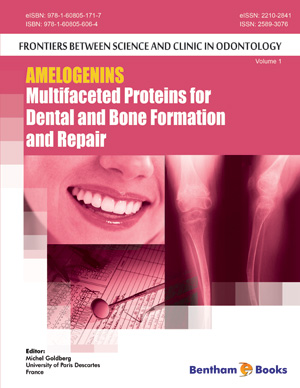Abstract
The amelogenin (AMEL) gene intron-exon structure, order and nucleotide sequence has been well preserved during evolutionary development. The variations of splicing of the nuclear pre-mRNA to produce the mRNA and subsequently translated proteins, depend on the sequence lengths of both the introns and exons, the presence of possible cryptic splice sites in large exons, the intrinsic “strengths” of the splice boundary sequences in interaction with the spliceosome components and the intervention of a variety of tissue and species specific accessory factors. A large number of splice isoforms has indeed been found; 16 alternative protein isoforms have been reported in mouse amelogenin, but the actual splicing patterns do differ in different animals. The major higher mass isoforms are used in building the amelogenin ECM and directing the organization and mineralization of the enamel. The question raised here is the role of the smaller isoforms? Their role appears to be largely as participants in regulatory processes during development of the enamel organ and in odontogenesis. However, it is becoming clear that amelogenin expression is not restricted to the enamel organ. Amelogenin peptides have been found in such diverse organs as brain, eye, cartilage and bone during embryogenesis. The knockout of amelogenin gene is not lethal, and these non-odontogenic tissues do form and appear to function normally, suggesting that the normal in vivo effects of the smaller splice isoforms may be subtle, modifying developmental rates, but it is evident that individual small amelogenin protein isoforms, added exogenously in vivo and in culture can markedly alter phenotypic expression in non-odontogenic tissues, as well as induce various forms of tissue repair in teeth. Thus, the study of the AMEL gene small isoforms and their mechanisms of action are fields worthy of extended study.
Keywords: Amelogenin, Splice Isoforms, LAMP1, Nitric Oxide Synthetase, Nitric Oxide, Enamel Formation, Non-Odontogenic Tissues, Tissue Repair






















